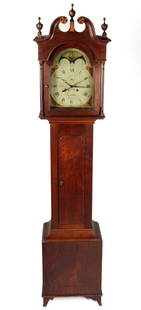

 Discovery- InteriorsBonhamsSponsored.Your ad here?
Discovery- InteriorsBonhamsSponsored.Your ad here?



Discovery- Interiors
Bonhams
Sponsored.Your ad here?


 Discovery- InteriorsBonhamsSponsored.Your ad here?
Discovery- InteriorsBonhamsSponsored.Your ad here?



Discovery- Interiors
Bonhams
Sponsored.Your ad here?

Table clock tournant after models of FRANÇOIS VION (ca. 1737- ca. 1790). France, 19th century.
Similar Sale History
View More Items in ClocksRelated Clocks
More Items in Clocks
View MoreRecommended Decorative Objects
View More








Item Details
Description
Table clock tournant after models by FRANÇOIS VION (ca. 1737- ca. 1790). France, 19th century.
White marble and gilt bronze. Circular blued dial with enamelled numerals.
The movement with the initials "J-G" on the inside in running order.
It is accompanied by a key.
It presents marks of use.
Measurements: 73 x 31 x 31 cm.
The magnificent tournant clock in tender is remarkable for its great similarity to the original model of the Three Graces, made by the Parisian bronze craftsman François Vion in collaboration with the watchmaker Pierre-Basile Lepaute (1750-1843) around 1769. The design appeared in an album of watchmaking pieces now in the Insitut National d'Histoire de l'Art in Paris. A watch identical to Vion's was presented to the Countess Du Barry at the Palace of Versailles on 4 October 1769, and another (which belonged to General Moreau) is in the Musée National du Château de Fontainebleau. It is a design heir to the German pivot clocks of the 16th century, a very fashionable typology in the Louis XVI style (1754-1793). In his original model, Vion depicted the Three Graces or Greek Carites, goddesses associated with love, beauty, sexuality and fertility, understood as life-giving forces. Their names were Aglaya ("Beauty"), Euphrosine ("Joy") and Thalia ("Festivities"), and they were considered daughters of Zeus and Eurynome, although other versions mention Hera, Dionysus or Helios and the naiad Egle as their progenitors. The representation of the three Graces was frequent from the Renaissance onwards, both because of their hermetic character, related to the mysteries, aesthetics and Greco-Latin thought, and because of the more mundane fact that their iconography allowed three beautiful naked girls to be depicted.
François Vion was an outstanding bronze caster who became a master in 1764. He collaborated with Pierre-Basile Lepaute (1750-1843), one of the leading watchmakers of the late 18th and early 19th centuries. Towards the end of the 18th century, he and his nephew Jean-Joseph Lepaute founded a new company that was active until 1811 and won a silver medal at the Exposition des Produits de l'Industrie in 1806. For several decades they were the main suppliers of watches to the Imperial and Royal Garde-Meuble; they were successively named Horloger de l'Empereur and Horloger du Roi.
White marble and gilt bronze. Circular blued dial with enamelled numerals.
The movement with the initials "J-G" on the inside in running order.
It is accompanied by a key.
It presents marks of use.
Measurements: 73 x 31 x 31 cm.
The magnificent tournant clock in tender is remarkable for its great similarity to the original model of the Three Graces, made by the Parisian bronze craftsman François Vion in collaboration with the watchmaker Pierre-Basile Lepaute (1750-1843) around 1769. The design appeared in an album of watchmaking pieces now in the Insitut National d'Histoire de l'Art in Paris. A watch identical to Vion's was presented to the Countess Du Barry at the Palace of Versailles on 4 October 1769, and another (which belonged to General Moreau) is in the Musée National du Château de Fontainebleau. It is a design heir to the German pivot clocks of the 16th century, a very fashionable typology in the Louis XVI style (1754-1793). In his original model, Vion depicted the Three Graces or Greek Carites, goddesses associated with love, beauty, sexuality and fertility, understood as life-giving forces. Their names were Aglaya ("Beauty"), Euphrosine ("Joy") and Thalia ("Festivities"), and they were considered daughters of Zeus and Eurynome, although other versions mention Hera, Dionysus or Helios and the naiad Egle as their progenitors. The representation of the three Graces was frequent from the Renaissance onwards, both because of their hermetic character, related to the mysteries, aesthetics and Greco-Latin thought, and because of the more mundane fact that their iconography allowed three beautiful naked girls to be depicted.
François Vion was an outstanding bronze caster who became a master in 1764. He collaborated with Pierre-Basile Lepaute (1750-1843), one of the leading watchmakers of the late 18th and early 19th centuries. Towards the end of the 18th century, he and his nephew Jean-Joseph Lepaute founded a new company that was active until 1811 and won a silver medal at the Exposition des Produits de l'Industrie in 1806. For several decades they were the main suppliers of watches to the Imperial and Royal Garde-Meuble; they were successively named Horloger de l'Empereur and Horloger du Roi.
Buyer's Premium
- 26%
Table clock tournant after models of FRANÇOIS VION (ca. 1737- ca. 1790). France, 19th century.
Estimate €10,000 - €12,000
19 bidders are watching this item.
Shipping & Pickup Options
Item located in Barcelona, Barcelona, esOffers In-House Shipping
Payment

Related Searches
TOP









































































